Contents
Derain white is found in the wild not only in Our Country, but also on other continents. Thanks to its beautiful appearance, this plant is well known to many lovers of ornamental shrubs and landscape designers. It is able to decorate the garden at any time of the year, while caring for it is very simple and will not be difficult even for inexperienced gardeners.
Description of white deren
In botanical literature, you can often find the following synonymous names for this plant:
- Dogwood white.
- Svidina is white.
- The certificate is white.
- Telecrania is white.
Derain white (Cornus Alba) is a perennial deciduous shrub with straight shoots. Belongs to the genus Kizilov, the Kizilov family.

The main characteristics of white deren are shown in the table.
Parameter | Value |
Shoots | Smooth, arched in old age, various shades of reddish (bright red in spring) color. |
Leaves | Elliptical, with a smooth edge, up to 10 cm long and up to 7 cm wide. Petioles are short, up to 1 cm. 3-5 arcuate veins are clearly distinguished on the leaf plate. The leaf plate is dark green above, gray below, pubescent on both sides. |
Flowers | Corollas with 4 white petals, collected in dense corymbs up to 5 cm in diameter at the ends of the shoots. |
Fruit | Inedible drupes are bluish in color, ripe – white or slightly bluish. |
Distribution | From the North-Western part of Our Country to the Far East. It is found in Western Europe, Mongolia and Japan, in China and Korea. |
Crown diameter of white derain
An adult bush of white derain can reach considerable sizes. Individual specimens can grow up to 5 m in diameter. Often the bushes standing next to each other are intertwined, forming impenetrable thickets. This feature of white dogwood is used by landscape designers when creating hedges.
White turf height
Free-standing svidina bushes can grow up to 3 m in height. In ornamental gardening and landscape design, their growth is often artificially limited by cutting shoots at a height of 1,5-1,7 m and giving a rounded shape.
How fast does white derain grow
White dogwood is distinguished by the rapid growth of shoots. During the year, their length can increase by 0,5 m or more, depending on care and weather conditions.
Derain white in landscape design
Derain white is a real find for beginner landscape designers. This plant looks great in individual plantings and in groups, while it does not lose its decorative effect even in winter. Its crown can be formed without fear for the consequences, since the shrub tolerates pruning perfectly.
Derain white in landscape design – in the photo below.
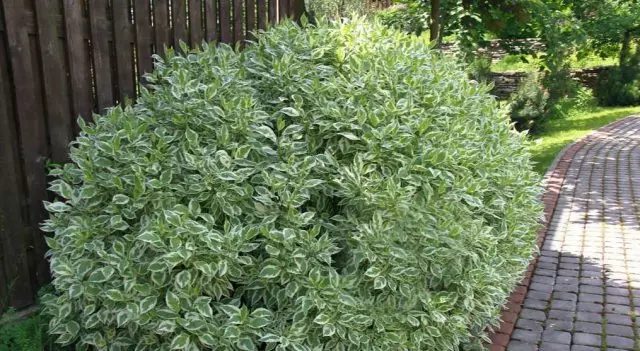
Derain white is widely used for landscaping streets, parks and squares, it is unpretentious and undemanding to care, it perfectly tolerates the vagaries of the weather and the gassiness of megacities. Often it is planted on the territories of health care institutions, hospitals and sanatoriums.
White turf hedge
Growing hedges is one of the main uses of white turf in landscape design. This is due to the decorative properties of this shrub, it does not lose its attractiveness at any time of the year. Deren is unpretentious in care and undemanding to the soil. It is easy to mold and tolerates pruning well. Hedges are great for camouflaging simple or nondescript fences, giving the area a more presentable look. They can also act as independent elements of a landscape gardening composition.
Growing a hedge from white deren is quite simple. To do this, seedlings are planted in a row at a distance of 1-1,2 m from each other. A year later (with autumn planting – after a year and a half), all the bushes are cut to the same height – 15-20 cm from the ground. This is done in early spring, before the start of the growing season. With the help of this technique, the growth of lateral shoots is stimulated, the thickening of the bushes artificially increases, the hedge is more dense. When the bushes reach the age of 3 years, you can begin to form a crown, cutting it in accordance with the selected type.

Derain white at a young age has fairly flexible shoots, so it is often used to form arches and semi-arches, thus making out paths and alleys. Initially, the branches are fixed with twine, giving them the desired direction. Over time, the shrub gets used to and independently retains the necessary shape.
What is combined with white derain
Derain is not an antagonist and goes well with almost all garden plants. It grows well next to other shrubs: barberry, spray roses, boxwood. For ornamental purposes, it is often planted next to coniferous trees.
Varieties of white derain
Derain white has quite a few varieties and varieties. Many of them are used in landscape design. Here are the most famous of them:
- Derain is white-edged.
- Derain white Kesselrings.
- Derain white Siberian.
- Derain white Argenteomarginata.
- Derren Ivoryhalo.
- Derain White Cream Cracker.
- Derain white Pearl.
- Derain white Svidina.
- Derain white Gouchalty.
- Derain white Variegata.
- Derain white Shpeta (Spaethii).
Photos and descriptions of the main varieties of white deren are given below.
Derain white-edged
Derain white-edged is a low shrub of deciduous type, widely distributed in Our Country, Europe and North America. Its distinguishing feature is the leaves: pointed-ovoid in shape, with a pronounced light stripe along the edge of the leaf plate. Due to this, the bush has a light openwork appearance, therefore it is used by many to decorate summer cottages and adjacent territories. In autumn, the color of the leaves changes to crimson with purple hues.
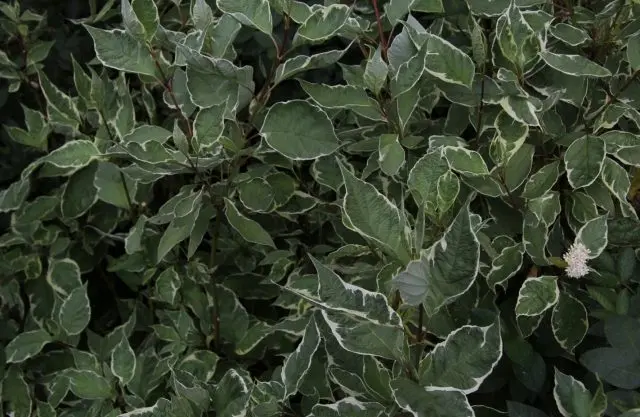
Beautiful derain is white-edged and during flowering, at this time it forms magnificent caps of white flowers. In their place, then brushes of small white-blue berries ripen, which also look quite attractive.
Derain white Kesselrings
Derain white Kesselringi (Kesselringii) is a deciduous shrub up to 3 m tall with a spreading crown. It is used for decorative purposes due to its attractive appearance. Differs in straight shoots of purple-violet, almost black color, looking very impressive in autumn, winter and spring.
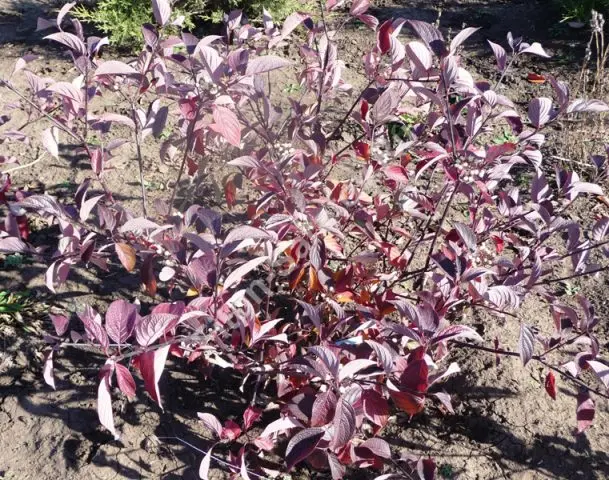
The leaves are dark green above and gray below, with a red-brown tint, oval, up to 12 cm long. In autumn, the leaf plate turns red-violet or brown-red. Blooms in early summer. The flowers are small, milky or cream-colored, collected in corymbs up to 5 cm in diameter. The fruits of white Kesselringa derain are spherical drupe berries, milky in color with a blue tint.
Therefore, in order to maintain a decorative appearance, it is necessary to carry out constant rejuvenating pruning, stimulating the growth of new branches.
Derain white Siberian
This variety is otherwise called white derain Sibirica (Sibirica). It is a deciduous shrub up to 2,5 m high and with a crown diameter of up to 2 m. A distinctive feature of the variety is the bright red color of young shoots. They may have a bloody or coral hue. Over time, the bark darkens, and its color becomes brown.

The leaves are variegated, green with white, in autumn their color can change to yellow, purple or purple. Blooms in late May or early June. The flowers are small, collected in inflorescences-scutes of small size.
Derain white Argenteomarginata
Derain white Argenteomarginata leaves partly resembles Siberia, but has larger bushes. Their height can exceed 3 m, the crown can reach 3 m in diameter. Shoots are even, straight, coral or red. The leaves are gray-green with an uneven white border, 3-8 cm long, ovate, pointed. In autumn, their color turns to purple-red.
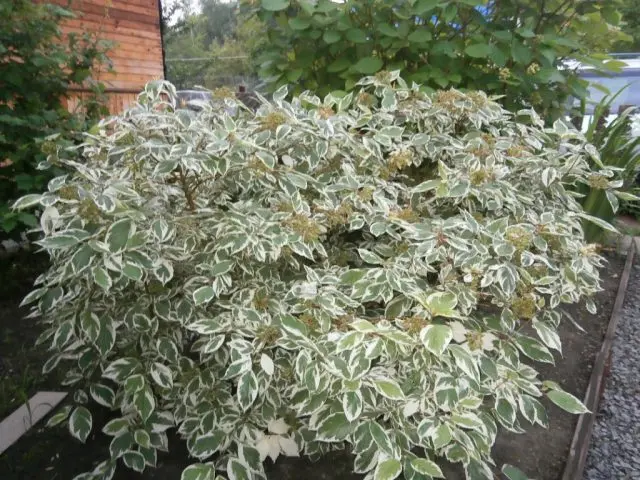
It usually blooms twice: the first time in May, the second in September. The flowers are small, yellowish-white, collected in corymbose inflorescences 3-5 cm in diameter. The fruits are round, milky-colored drupes that acquire a bluish tint when ripe.
Derren Ivoryhalo
Derain white IvoryHalo (Cornusalba ‘IvoryHalo’) is a low compact deciduous shrub whose height does not exceed 1,5 m. The shoots are thin, even, vertically growing, unbranched. The color of the bark can vary from dark red to cherry.
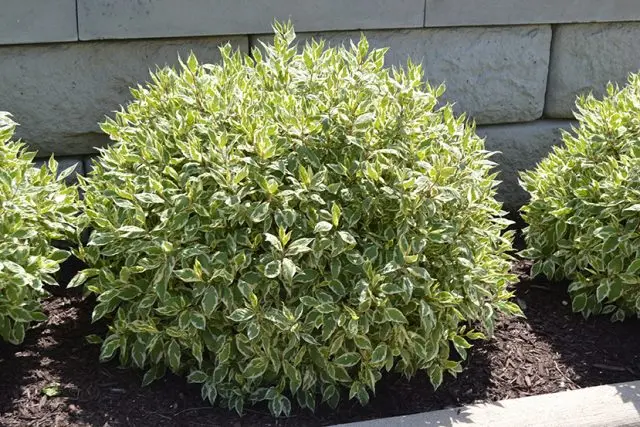
The leaves are medium-sized, with an uneven white border, green, pointed. The lower part of the sheet platinum is lighter. Leaves turn purplish red in autumn. The flowers are small, yellowish, grow in small corymbose inflorescences. The fruits are berry-like, not numerous, spherical, medium-sized, milky, and in a ripe state of a pale blue color.
Derain White Cream Cracker
Cream Cracker is another variety of derain, very popular among landscape designers around the world. It is a low, up to 1,5 m, compact bush with a loose crown. Shoots are even, vertical, purple-red.
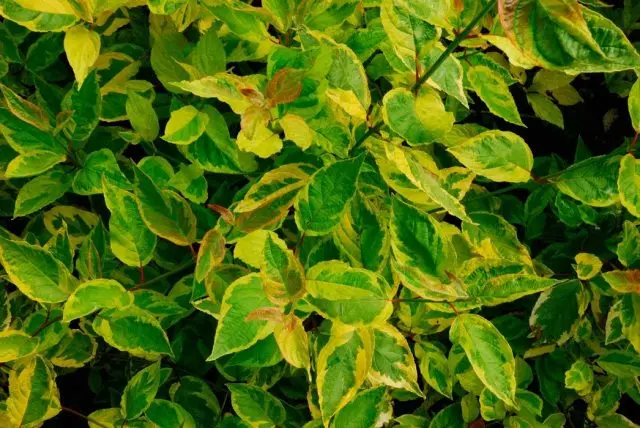
Young leaves are green, with a white border around the edges, with time the color of the border changes to cream. The flowers are small, cream-colored, collected in medium-sized inflorescences in the form of corymbs. In their place, then a few berry-like milky fruits are formed.
Derain White Pearl
Fully this variety is called the Pearl of Siberia (Cornusalba ‘SiberianPearls’). This is a fairly tall (2-2,2 m) deciduous shrub with bright red shoots.
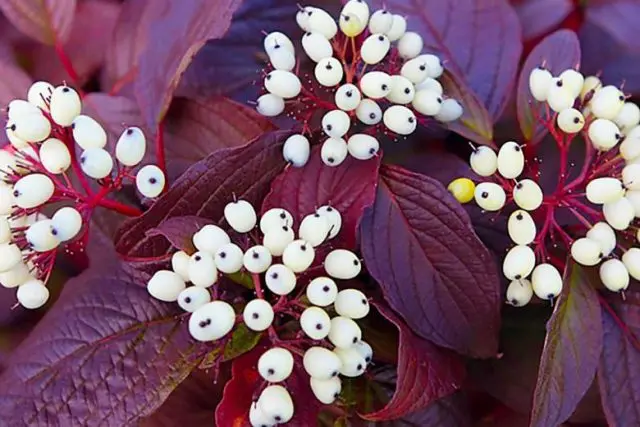
The leaves are dark green, slightly wrinkled, the lower part of the leaf plate is bluish in color. Turn purple-red in autumn. Blooms very profusely in early June. Fragrant white flowers are collected in large convex corymbose inflorescences. Fruiting is just as plentiful. The berries are numerous, milky in color, when ripe they acquire a pinkish-bluish hue.
Derain white Svidina
Svidina is one of the names of white deren (Cornusalba). The adult bush of this plant usually reaches 3 m in height, the diameter of its crown becomes the same size. It is a deciduous shrub with red shoots.

The leaves are dark green, slightly wrinkled, ovoid with a pointed end. In autumn they turn purple-red. Blooms in May, rarely in June. Numerous medium-sized white flowers are collected in inflorescences in the form of corymbs. Fruits are drupes of milky color, when ripe they become bluish.
Derain White Gouchaulty
Derain white Gouchaulti (Cornusalba Gouchaultii) is a rather tall (3 m and above) sprawling deciduous shrub. Shoots are dark red, smooth, thin.
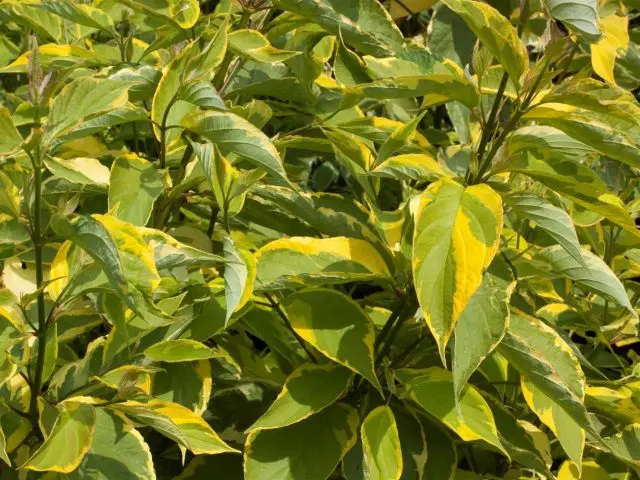
The leaves of this variety of white deren are green, ovoid, pointed, have an uneven yellow border with a pinkish tinge. The flowers are white, grow in corymbose inflorescences. The fruits are spherical, white or bluish.
Derain white Variegata
This variety is also called Sibirika Variegata. This is a low deciduous shrub, reaching a height of 1,5 m. Variegata differs from Sibirika by the presence of a creamy white border on dark green leaves. In autumn, their color changes to purple, yellow or purple.
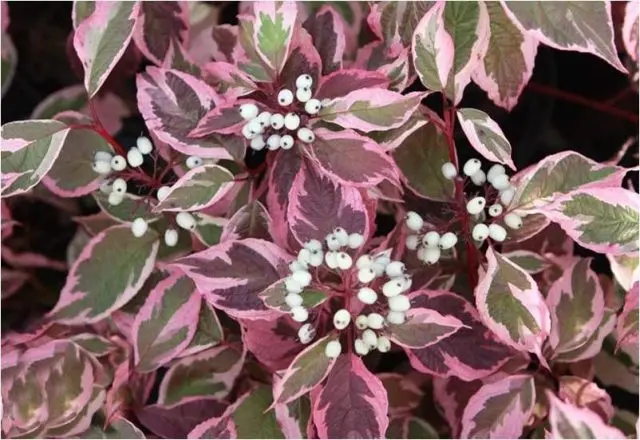
Shoots are long, thin, even. The bark is coral red to dark brown in color. It can bloom twice during the year: the first time in May, the second – in early autumn. The flowers are whitish-cream, small, collected in a shield. The fruits are round, milky with a blue tint.
Planting and care of white deren
Derain white – an extremely unpretentious plant that does not require special care. It does not impose special requirements on the composition of the soil, the regularity of watering or the prevention of diseases. The birthplace of this plant is Siberia, so the shrub is hardy, winter-hardy and picky.
Terms and rules for planting white deren
For the most decorative look, it is better to choose open areas or light partial shade. This is not of decisive importance for the development of the plant, although it gives it a great decorative effect. This shrub grows well on moist, fertile soils, but this factor can be ignored. Any areas are suitable for planting: clay, rocky soil, sand – white turf will grow everywhere if a sufficient level of humidity is provided.
For planting, it is better to choose autumn or early spring. If a seedling has a clod of earth on its roots, this is almost a 100% guarantee that it will take root. At this time, planting pits are prepared about a third larger than the volume of the root system of the seedling. If the soil is poor, before planting, it is worth adding a small amount of complex mineral fertilizer or humus to the hole.

The landing procedure is not difficult. The seedling is placed vertically in the hole so that the root neck is at ground level. Then the root system is covered with earth, lightly tamped down and abundant watering of the root zone is carried out. If planting was carried out in the spring, it is better to mulch the ground around the seedling with peat, this will help retain moisture.
Watering white derain
As a rule, watering is not required for this shrub. If the landing site is chosen correctly, soil moisture and precipitation will be quite enough. An exception can be made only in dry summer periods. At this time, you can water the bushes once a week at the rate of 1-1 buckets of water under each bush.
Additional fertilizing
It is not necessary to feed the shrub. Separate ornamental species can be fed once a year, in the spring, by applying a complex mineral fertilizer to the root zone. Peat or humus will serve as additional top dressing if the root zone is mulched with it.
When to cut white turf
This shrub grows quickly and chaotically, so without pruning it will very soon resemble a large shapeless pile. Cut plants several times a season. In the spring, a sanitary cutting is carried out, removing dried or broken branches. The rest of the time, the selected crown shape is maintained, while the haircut is done every 3-4 weeks. The last time the bush is cut is usually in late July or early August.
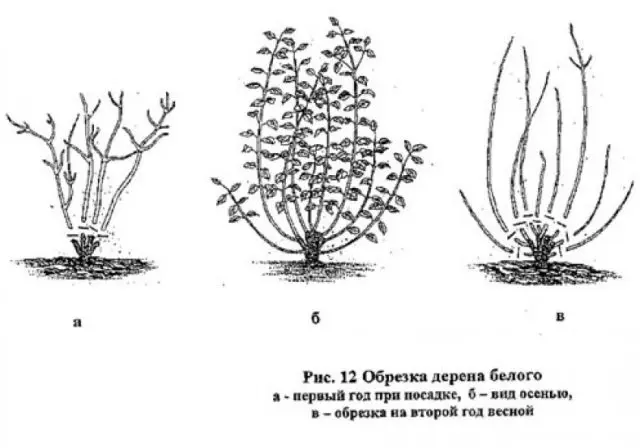
The bright red stems of the plant serve as a garden decoration in winter. Therefore, rejuvenating pruning “on a stump”, i.e. shortening the white sod bushes to a height of 15–20 cm from the ground to stimulate the growth of new shoots, is done in early spring, before the start of the growing season. After pruning, it is necessary to sprinkle the hemp with ash to prevent infection.
Pruning and shaping a white derain bush
The full formation of the crown can begin after the shrub reaches the age of 3 years. Most often, white sod is used in group planting to form hedges, so the crown is cut in accordance with the chosen style: hemisphere, rectangle, etc. Separately growing decorative bushes are most often formed in the form of various geometric shapes. Professionals often form a bush in the form of chess pieces, animals, candle flames.
Preparation for winter
Due to the amazing frost resistance of most varieties of this plant, no preparation for the winter period is carried out. It is enough just to fill the bush with snow. Only young bushes of non-frost-resistant varieties are dug up and stored in the basement in winter.
Flowering deren white
The shrub blooms quite beautifully. Small white or cream flowers are collected in small inflorescences – shields. The size of each inflorescence depends on the variety and is about 5 cm.

Deren usually blooms in May or early June, but many varieties bloom again in early autumn.
Propagation of white deren
This ornamental shrub can be propagated by any vegetative method:
- cuttings;
- layering;
- division of the bush.
The seed method of reproduction is also acceptable, but is not used due to the long periods. In addition, with this method, varietal characteristics of the plant are not preserved.
How to propagate white derain cuttings
In spring and autumn, cuttings can be harvested using strong shoots with well-developed buds. Each cutting should have 7-10 pieces. They are usually rooted in early spring. The cut is treated with a weak solution of succinic acid. Then the cuttings are planted in a container with nutrient soil and placed under the film.
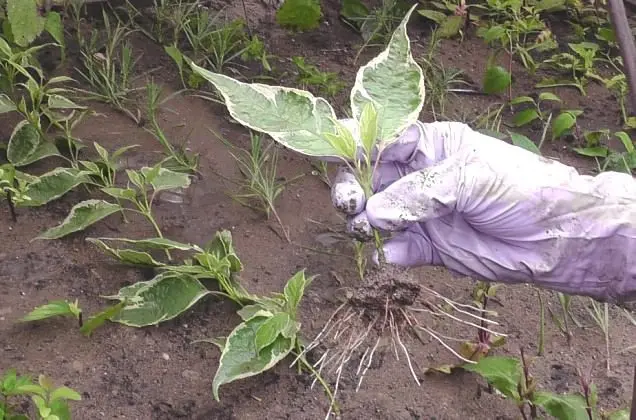
If rooting has occurred, all the buds will open and put out new leaves. During the summer, it is necessary to periodically water and ventilate the container with the cuttings, as well as feed them with a fertilizer solution or organic matter. By autumn, the seedlings will have their own developed root system and can be transplanted to a permanent place.
How to propagate by layering
Often a plant takes root in this way on its own, if its growing shoots touch the ground. To obtain layering, it is enough to fix one of the flexible side stems near the surface of the earth in the spring and sprinkle it with soil. If you regularly water this place, the shoot will give roots and release a new shoot. After winter, the mother shoot can be cut off, and the cuttings can be dug up along with a clod of earth and transplanted to another place.
How to propagate by seeds
Seeds are used for propagation of only pure forms of turf, since with this method of reproduction, the young plant completely or partially loses all varietal characteristics. Seeds are collected in autumn, from fully ripened fruits. As a rule, they have good germination. Landing is carried out in the fall, usually in October, immediately in open ground. During the winter, they will undergo a stratification procedure, harden and germinate in the spring.
Diseases and pests of white deren
Diseases often affect young, immature bushes, since adult plants have good immunity and rarely get sick. The greatest danger to him is powdery mildew, a fungal disease that all horticultural crops are more or less susceptible to. The fungus begins to develop from the bottom of the plant, gradually all of it becomes covered with a light bloom and brown spots, and then dries out and dies.

To avoid infection, do not plant plants too close to each other. Watering should be carried out only at the root. In autumn, the root zone must be cleared of fallen leaves, since spores of the fungus can overwinter in it. At the first signs of the onset of the disease, the affected areas of the crown must be cut out and burned, and the bush should be treated with a solution of laundry soap, soda ash or garlic infusion.
Of the insect pests on white derain, midges, aphids and comma-shaped scale insects most often appear. To combat them, insecticides are used (Decis, Karbofos), as well as infusions of wormwood, celandine, tobacco or onions.
Conclusion
Derain white is a versatile plant that can decorate a garden or park area at any time of the year. Unpretentiousness in care, undemanding to the place of growth and composition of the soil, the plasticity of the crown and the rapid growth of shoots make it an excellent tool for both beginner landscape designers and real high-level artists. It is also important that the seedlings of this shrub can be found not only in nurseries and shops. Often deren grows near roads and rivers, in wastelands and abandoned areas. You just need to pay attention to it.









